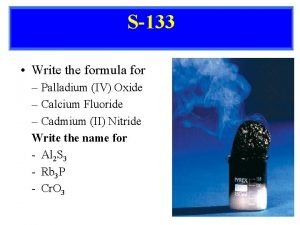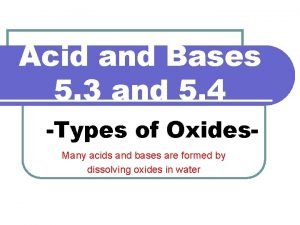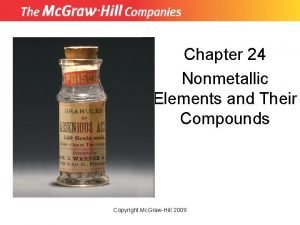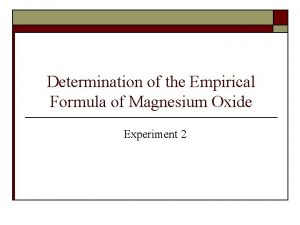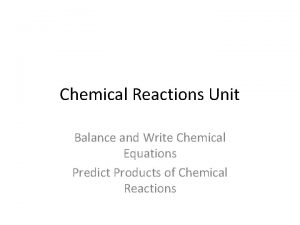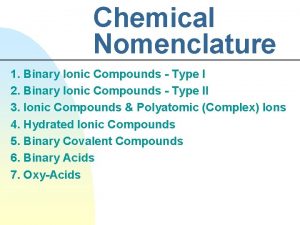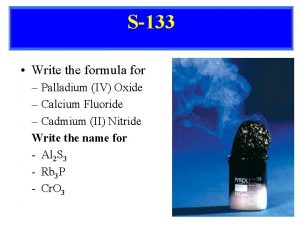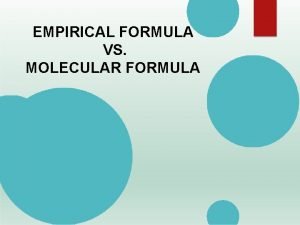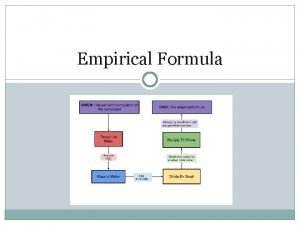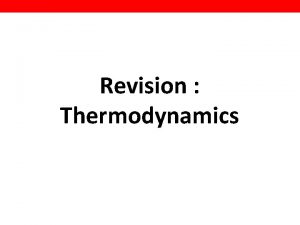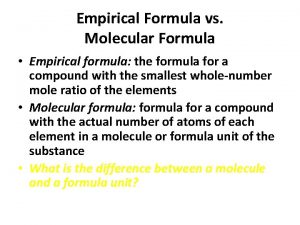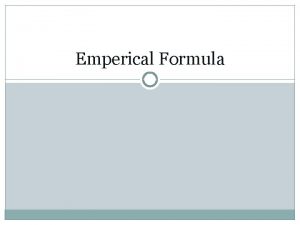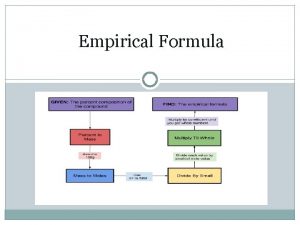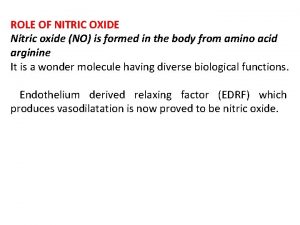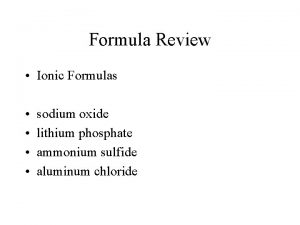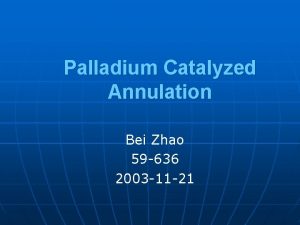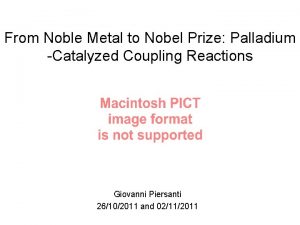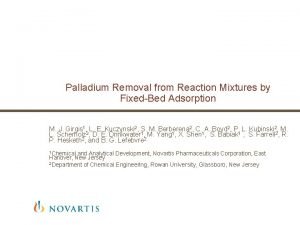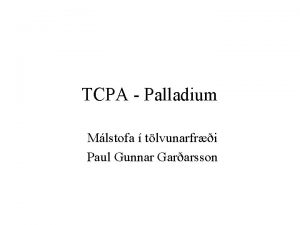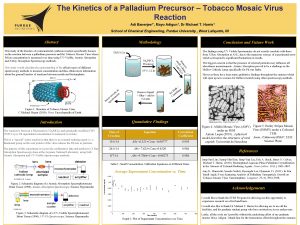S133 Write the formula for Palladium IV Oxide


























- Slides: 26

S-133 • Write the formula for – Palladium (IV) Oxide – Calcium Fluoride – Cadmium (II) Nitride Write the name for - Al 2 S 3 - Rb 3 P - Cr. O 3

Unit 7 Chemical Reaction SPS 2. Students will explore the nature of matter, its classifications, and its system for naming types of matter. d. Demonstrate the Law of Conservation of Matter in a chemical reaction. e. Apply the Law of Conservation of Matter by balancing the following types of chemical equations; 1. 2. 3. 4. Synthesis Decomposition Single Replacement Double Replacement

7. 1 Describing Reactions What is the law of conservation of mass? Why must chemical equations be balanced? Why do chemists use the mole? How can you calculate the mass of a reactant or product in a chemical reaction?

7. 1 Describing Reactions What is the law of conservation of mass? • Chemical Equations – Reactants – the substances that are present before a reaction – Products – the substances present after a reaction is complete – Always given in the form Reactants Products – Example: Carbon + Oxygen Carbon Dioxide – Or C + O 2 CO 2

7. 1 Describing Reactions What is the law of conservation of mass? • Writing Equations - Practice – Copper and Oxygen make Copper (II) Oxide – Magnesium and Hydrogen Chloride make Hydrogen and Magnesium Chloride – Ethylene (C 2 H 4) burns with Oxygen to produce Carbon Dioxide and Water. – Hydrogen and Chlorine combine to make Hydrogen Chloride

7. 1 Describing Reactions What is the law of conservation of mass? • Conservation of Mass – Mass is not created or destroyed in a chemical reaction – For practical purposes • Same types of atoms before and after a reaction • Same number of each type of atom before and after – Equations must show this – They are called balanced equations

S-134 • Write the formula for – Dinitrogen Trioxide – Copper (II) oxide – Dinitrogen Pentaoxide Write the name for - CCl 4 - Cr. Br 3 - Mo 2 O 5

S-135 • Write the equation for a reaction of hydrogen sulfide with aluminum oxide to make aluminum sulfide and water.

7. 1 Describing Reactions Why must chemical equations be balanced? • Balancing Equations – If an equation does not have the same elements on both sides, it is a false equation • Can not actually occur – Coefficient – a number placed in front of a substance in a chemical equation • Used to balance equations

7. 1 Describing Reactions Why must chemical equations be balanced? • Balancing Equations - Steps – First write out the equation • Hydrogen and Oxygen make water becomes • H 2 + O 2 H 2 O – List the elements on each side H-2 O-2 H-2 O-1 – Add substances until both sides are equal

7. 1 Describing Reactions Why must chemical equations be balanced? • Balancing Equations - Practice – Copper and Oxygen make Copper (II) Oxide – Magnesium and Hydrogen Chloride make Hydrogen and Magnesium Chloride – Ethylene (C 2 H 4) burns with Oxygen to produce Carbon Dioxide and Water.

S-137 • Balance the following equations H 2 SO 4 + Al(OH)3 Al 2(SO 4)3 + H 2 O

7. 1 Describing Reactions Why do chemists use the mole? • Counting With Moles 18 Ar 39. 95 – A unit of measurement Argon 23 – Equals 6. 02 x 10 of anything – Used only to count atoms, molecules, formula unit – One mole of an element is equal to its atomic mass converted to grams (put a g beside the number)

7. 1 Describing Reactions How can you calculate the mass of a reactant or product in a reaction? • Molar Mass – For an element equal to its atomic mass – For a compound • For each element – multiply the mass x the number of that element in the compound • Add the total

7. 1 Describing Reactions How can you calculate the mass of a reactant or product in a reaction? • Molar Mass-Example – C 2 H 4 – Carbon – Hydrogen – 12. 01 g x 2 = 24. 02 g 1. 01 g x 4 = 4. 04 g Total 28. 06

7. 1 Describing Reactions How can you calculate the mass of a reactant or product in a reaction? • Molar Mass-Example – Pb(OH)4

S-137 • What is the molar mass of Al 2(SO 4)3

7. 2 Types of Reactions What are the general types of chemical reactions?

Types of Reactions What are the general types of reactions? • Classifying Reactions – Describe how reactants interact to form products – Help to predict the products of reactions

Types of Reactions What are the general types of reactions? • Synthesis – Two or more substances react to form a single substance – Pattern A + B AB – Always has one product – Examples • • 2 Na + Cl 2 2 Na. Cl 2 H 2 + O 2 2 H 2 O

Types of Reactions What are the general types of reactions? • Decomposition – One substance breaks apart into two or more products – Pattern AB A + B – Always has one reactant – Examples • • Ca. CO 3 Ca. O + CO 2 2 H 2 O 2 H 2 + O 2

Types of Reactions What are the general types of reactions? • Single Replacement (Displacement) – A compound switches parts with an element – Pattern A + BC B + AC – Always has one element and one compound on each side – Examples • • Cu + 2 Ag. NO 3 2 Ag + Cu(NO 3)2 2 K + 2 H 2 O H 2 + KOH

Types of Reactions What are the general types of reactions? • Double Replacement (Displacement) – – – Two compounds switch parts Often results in the formation of a precipitate Pattern AB + CD AD + CB Always has two compounds on each side Examples • • Pb(NO 3)2 + 2 KI Pb. I 2 + 2 KNO 3 Ca. CO 3 + 2 HCl Ca. Cl 2 + H 2 CO 3

Types of Reactions What are the general types of reactions? • Combustion – – – Reacts rapidly with oxygen Everything combines with oxygen Pattern AB + O 2 AO + BO Always has oxygen as a reactant Examples • • CH 4 + O 2 CO 2 + 2 H 2 O 2 Ca + O 2 2 Ca. O

S-138 • Balance the following reactions and tell what type(s) they are. 1. Pb(NO 3)2 + HCl Pb. Cl 2 + HNO 3 2. Ca + HCl Ca. Cl 2 + H 2

S-139 • Write out the reaction, then balance it and tell what type it is. 1. Mercury reacts with oxygen to form Mercury (II) Oxide
 Palladium (iv) oxide formula
Palladium (iv) oxide formula Basic oxides
Basic oxides Treponema palladium
Treponema palladium Inovasi palladium
Inovasi palladium Oxide, peroxide superoxide formula
Oxide, peroxide superoxide formula Empirical formula of tin oxide
Empirical formula of tin oxide Balancing combustion reactions
Balancing combustion reactions Binary compound
Binary compound Kontinuitetshantering
Kontinuitetshantering Typiska novell drag
Typiska novell drag Nationell inriktning för artificiell intelligens
Nationell inriktning för artificiell intelligens Vad står k.r.å.k.a.n för
Vad står k.r.å.k.a.n för Varför kallas perioden 1918-1939 för mellankrigstiden
Varför kallas perioden 1918-1939 för mellankrigstiden En lathund för arbete med kontinuitetshantering
En lathund för arbete med kontinuitetshantering Personalliggare bygg undantag
Personalliggare bygg undantag Personlig tidbok fylla i
Personlig tidbok fylla i Anatomi organ reproduksi
Anatomi organ reproduksi Vad är densitet
Vad är densitet Datorkunskap för nybörjare
Datorkunskap för nybörjare Stig kerman
Stig kerman Debattartikel struktur
Debattartikel struktur Delegerande ledarskap
Delegerande ledarskap Nyckelkompetenser för livslångt lärande
Nyckelkompetenser för livslångt lärande Påbyggnader för flakfordon
Påbyggnader för flakfordon Formel för lufttryck
Formel för lufttryck Offentlig förvaltning
Offentlig förvaltning I gullregnens månad
I gullregnens månad
